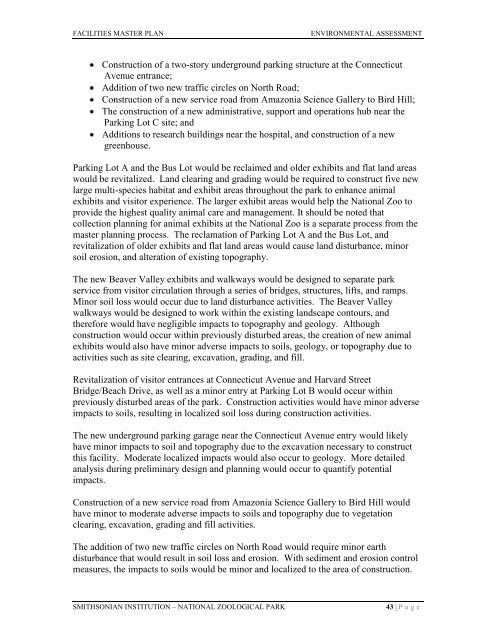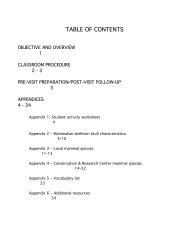facilities renewal master plan - National Zoo - Smithsonian Institution
facilities renewal master plan - National Zoo - Smithsonian Institution
facilities renewal master plan - National Zoo - Smithsonian Institution
Create successful ePaper yourself
Turn your PDF publications into a flip-book with our unique Google optimized e-Paper software.
FACILITIES MASTER PLAN ENVIRONMENTAL ASSESSMENT<br />
Construction of a two-story underground parking structure at the Connecticut<br />
Avenue entrance;<br />
Addition of two new traffic circles on North Road;<br />
Construction of a new service road from Amazonia Science Gallery to Bird Hill;<br />
The construction of a new administrative, support and operations hub near the<br />
Parking Lot C site; and<br />
Additions to research buildings near the hospital, and construction of a new<br />
greenhouse.<br />
Parking Lot A and the Bus Lot would be reclaimed and older exhibits and flat land areas<br />
would be revitalized. Land clearing and grading would be required to construct five new<br />
large multi-species habitat and exhibit areas throughout the park to enhance animal<br />
exhibits and visitor experience. The larger exhibit areas would help the <strong>National</strong> <strong>Zoo</strong> to<br />
provide the highest quality animal care and management. It should be noted that<br />
collection <strong>plan</strong>ning for animal exhibits at the <strong>National</strong> <strong>Zoo</strong> is a separate process from the<br />
<strong>master</strong> <strong>plan</strong>ning process. The reclamation of Parking Lot A and the Bus Lot, and<br />
revitalization of older exhibits and flat land areas would cause land disturbance, minor<br />
soil erosion, and alteration of existing topography.<br />
The new Beaver Valley exhibits and walkways would be designed to separate park<br />
service from visitor circulation through a series of bridges, structures, lifts, and ramps.<br />
Minor soil loss would occur due to land disturbance activities. The Beaver Valley<br />
walkways would be designed to work within the existing landscape contours, and<br />
therefore would have negligible impacts to topography and geology. Although<br />
construction would occur within previously disturbed areas, the creation of new animal<br />
exhibits would also have minor adverse impacts to soils, geology, or topography due to<br />
activities such as site clearing, excavation, grading, and fill.<br />
Revitalization of visitor entrances at Connecticut Avenue and Harvard Street<br />
Bridge/Beach Drive, as well as a minor entry at Parking Lot B would occur within<br />
previously disturbed areas of the park. Construction activities would have minor adverse<br />
impacts to soils, resulting in localized soil loss during construction activities.<br />
The new underground parking garage near the Connecticut Avenue entry would likely<br />
have minor impacts to soil and topography due to the excavation necessary to construct<br />
this facility. Moderate localized impacts would also occur to geology. More detailed<br />
analysis during preliminary design and <strong>plan</strong>ning would occur to quantify potential<br />
impacts.<br />
Construction of a new service road from Amazonia Science Gallery to Bird Hill would<br />
have minor to moderate adverse impacts to soils and topography due to vegetation<br />
clearing, excavation, grading and fill activities.<br />
The addition of two new traffic circles on North Road would require minor earth<br />
disturbance that would result in soil loss and erosion. With sediment and erosion control<br />
measures, the impacts to soils would be minor and localized to the area of construction.<br />
SMITHSONIAN INSTITUTION – NATIONAL ZOOLOGICAL PARK 43 | P a g e

















